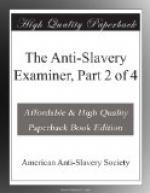“It is,” affirms the Princeton professor, “on all hands acknowledged, that, at the time of the advent of Jesus Christ, slavery in its worst forms prevailed over the whole world. The Savior found it around him in JUDEA."[A] To say that he found it in Judea, is to speak ambiguously. Many things were to be found “in Judea,” which neither belonged to, nor were characteristic of the Jews. It is not denied that the Gentiles, who resided among them, might have had slaves; but of the Jews this is denied. How could the professor take that as granted, the proof of which entered vitally into the argument and was essential to the soundness of the conclusions to which he would conduct us? How could he take advantage of an ambiguous expression to conduct his confiding readers on to a position which, if his own eyes were open, he must have known they could not hold in the light of open day?
[Footnote A: Pittsburgh pamphlet p. 9.]
We do not charge the Savior with any want of wisdom, goodness, or courage,[B] for refusing to “break down the wall of partition between Jews and Gentiles” “before the time appointed.” While this barrier stood, he could not, consistently with the plan of redemption, impart instruction freely to the Gentiles. To some extent, and on extraordinary occasions, he might have done so. But his business then was with “the lost sheep of the house of Israel."[C] The propriety of this arrangement is not the matter of dispute between the Princeton professor and ourselves.
[Footnote B: The same, p. 10.]
[Footnote C: Matt. xv. 24.]
In disposing of the question whether the Jews held slaves during our Savior’s incarnation among them, the following points deserve earnest attention:—
1. Slaveholding is inconsistent with the Mosaic economy. For the proof of this, we would refer our readers, among other arguments more or less appropriate and powerful, to the tract already alluded to.[A] In all the external relations and visible arrangements of life, the Jews, during our Savior’s ministry among them, seem to have been scrupulously observant of the institutions and usages of the “Old Dispensation.” They stood far aloof from whatever was characteristic of Samaritans and Gentiles. From idolatry and slaveholding—those twin-vices which had always so greatly prevailed among the heathen—they seem at length, as the result of a most painful discipline, to have been effectually divorced.
[Footnote A: “The Bible against Slavery.”]
2. While, therefore, John the Baptist, with marked fidelity and great power, acted among the Jews the part of a reprover, he found no occasion to repeat and apply the language of his predecessors,[B] in exposing and rebuking idolatry and slaveholding. Could he, the greatest of the prophets, have been less effectually aroused by the presence of “the yoke,” than was Isaiah?—or less intrepid and decisive in exposing and denouncing the sin of oppression under its most hateful and injurious forms?




